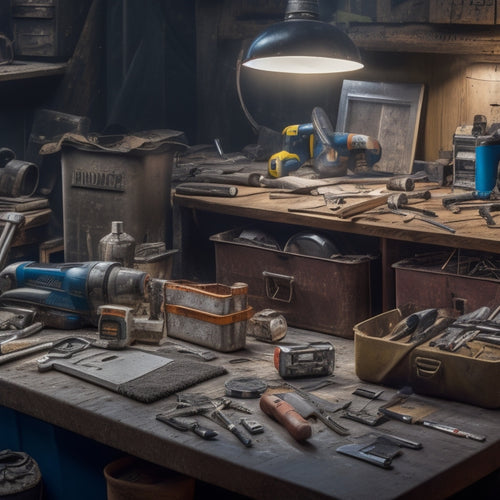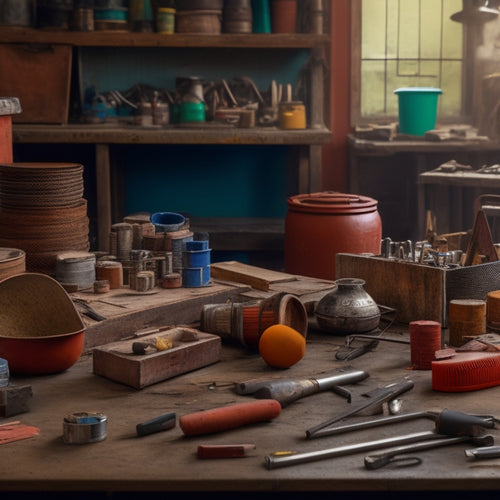
Best Concrete Repair Compounds for Home Renovation
Share
When selecting the best concrete repair compounds for your home renovation, you'll want to reflect on top brands like Sika, Master Builders Solutions, and Kryton, known for their high-quality and innovative solutions. Epoxy-based compounds offer high-strength bonding, chemical resistance, and advanced bonding techniques, while cement-based products provide durability and resistance to water and chemicals. Acrylic compounds excel in high-traffic areas and harsh weather conditions. With various formulations and application methods, it's important to evaluate your project's specific needs and choose the right compound for a long-lasting repair. Dive deeper to discover the ideal solution for your project.
Key Takeaways
• Industry leaders like Sika, Master Builders Solutions, and Kryton offer high-quality concrete repair compounds with distinct formulations and performance.
• Epoxy-based, cement-based, and acrylic repair compounds cater to different needs, such as high-strength bonding, durability, and rapid curing.
• Performance characteristics like high-strength bonding capacity, versatile mix ratios, and chemical resistance are crucial in choosing the right repair compound.
• Polyurethane foam injection methods provide high-strength stabilization for moisture-prone areas, and selecting the right injection equipment is critical for success.
• Proper surface preparation, application techniques, and safety precautions are essential for a successful concrete repair, and DIY projects may require professional expertise.
Top Concrete Repair Compound Brands
You'll find top-performing concrete repair compounds from brands like Sika, Master Builders Solutions, and Kryton, which have established themselves as industry leaders through their commitment to quality and innovation.
These top brands have developed a reputation for delivering reliable and effective solutions for concrete repair and restoration.
When comparing products from these brands, you'll notice distinct differences in their formulations, application methods, and performance characteristics.
For instance, Sika's concrete repair compounds are known for their high-strength, rapid-setting properties, making them ideal for structural repairs.
Master Builders Solutions, on the other hand, offers a range of products that cater to specific repair needs, such as crack injection and surface protection.
Kryton's products, meanwhile, are recognized for their advanced waterproofing technology and durability.
Epoxy-Based Repair Compounds Review
When you're evaluating epoxy-based repair compounds, you'll want to contemplate their high-strength bonding capacity, which enables them to effectively repair cracks and damage in concrete structures.
You'll also appreciate the versatility of these compounds, as they often come with mix ratios that can be customized to suit specific repair tasks.
Additionally, you'll find that epoxy-based repair compounds offer impressive chemical resistance performance, making them ideal for use in environments where concrete is exposed to corrosive substances.
High-Strength Bonding Capacity
Epoxy-based repair compounds boast exceptional high-strength bonding capacity, making them an ideal choice for concrete repairs that require enduring, long-term results. You'll appreciate the high strength advantages of epoxy-based compounds, which enable them to withstand heavy loads and harsh environmental conditions. These compounds utilize advanced bonding techniques to create an unyielding bond between the repair material and the existing concrete.
Here are some key benefits of epoxy-based repair compounds with high-strength bonding capacity:
| Feature | Benefit | Description |
|---|---|---|
| High compressive strength | Withstands heavy loads | up to 10,000 psi |
| Chemical resistance | Resists harsh chemicals | acids, alkalis, and salts |
| Low shrinkage | Minimizes repair material movement | guarantees a stable bond |
| High tensile strength | Resists cracking and deformation | up to 5,000 psi |
When selecting an epoxy-based repair compound, look for products that offer high-strength bonding capacity to guarantee a durable and long-lasting repair. By choosing the right product, you'll be able to achieve professional-grade results that will withstand the test of time.
Versatile Mix Ratios Available
With high-strength bonding capacity in mind, you can now explore the versatility of epoxy-based repair compounds, which offer a range of mix ratios to suit various concrete repair applications and environmental conditions.
These mix ratios can be tailored to meet specific requirements, ensuring ideal performance in different scenarios. For instance, a 1:1 mix ratio may be perfect for general-purpose repairs, while a 2:1 or 3:1 ratio might be more suitable for high-traffic areas or extreme weather conditions.
You can also create custom blend ratios to address unique challenges, such as patching large cracks or filling deep holes. This flexibility allows you to fine-tune the compound's properties to match the specific demands of your project.
Chemical Resistance Performance
In harsh environments where chemical exposure is a concern, you'll find that epoxy-based repair compounds deliver exceptional chemical resistance performance, shielding the underlying concrete from corrosive substances and guaranteeing the long-term integrity of your repairs. This is vital in industrial settings, where acidic or alkaline substances can compromise the structural integrity of the concrete.
To evaluate the chemical resistance of epoxy-based repair compounds, manufacturers conduct rigorous testing, including ASTM C267 and C1202 standards. The results of these tests are often presented in tables, like the one below:
| Chemical | Concentration | Resistance |
|---|---|---|
| Sulfuric Acid | 10% | Excellent |
| Sodium Hydroxide | 50% | Good |
| Acetic Acid | 5% | Excellent |
These tests demonstrate the compounds' ability to withstand corrosive substances, guaranteeing long-term durability and minimizing the need for future repairs. When selecting an epoxy-based repair compound, look for products that have undergone rigorous chemical resistance testing and have a proven track record of delivering exceptional performance in harsh environments. By doing so, you can ascertain that your repairs will withstand the test of time and maintain their integrity in the face of chemical exposure.
Polyurethane Foam Injection Methods
When you're considering polyurethane foam injection methods for concrete repair, you'll want to understand the foam injection process, including the steps involved and the necessary preparation.
You'll also want to know the benefits of polyurethane foam, such as its high expansion ratio and ability to fill voids.
Foam Injection Process
You'll typically use polyurethane foam injection methods to fill concrete voids and stabilize surrounding soil by injecting a two-component resin through drilled holes. This process allows you to target specific areas of damage, guaranteeing a precise and effective repair.
The foam properties, such as its expansion rate and density, play a vital role in the success of the repair. By understanding these properties, you can select the right foam for the job and adjust your application techniques accordingly.
When injecting the foam, you'll need to take into account factors like injection pressure, flow rate, and hole spacing to achieve peak results. The foam will expand to fill the void, and its adhesive properties will bond with the surrounding concrete, creating a strong and durable repair.
Proper application techniques, such as using the correct drill bits and injection equipment, are also essential to guarantee a successful repair. By mastering the foam injection process, you'll be able to tackle complex concrete repairs with confidence, achieving professional-grade results that will last for years to come.
Polyurethane Foam Benefits
Polyurethane foam injection methods offer a range of benefits that make them a popular choice for concrete repair, including their ability to provide high-strength stabilization and fill voids of varying sizes.
When you use polyurethane foam injection methods, you can expect a high-strength, durable solution that will last for years to come. One of the significant advantages of polyurethane foam is its ability to expand up to 20 times its original volume, making it an ideal solution for filling large voids and cavities.
This expansion also allows the foam to exert pressure on the surrounding soil, providing additional stability to the concrete. Additionally, polyurethane foam is resistant to water and chemicals, making it an excellent choice for applications where moisture is present.
As a homeowner, you'll appreciate the versatility of polyurethane applications, which can be used for foam insulation, concrete lifting, and soil stabilization.
With polyurethane foam injection methods, you can rest assured that your concrete repair will be strong, durable, and long-lasting.
Injection Equipment Options
Selecting the right injection equipment is fundamental to the success of polyurethane foam injection methods, as it directly impacts the quality and efficiency of the concrete repair process. You'll need to evaluate factors like pressure, flow rate, and portability when choosing your equipment. Different injection techniques require specific equipment, so it's imperative to understand your project's requirements.
Here are some common injection equipment options:
| Equipment Type | Description |
|---|---|
| Low-Pressure Pumps | Ideal for small to medium-sized repairs, these pumps provide a controlled flow rate and are easy to maintain. |
| High-Pressure Pumps | Suitable for large-scale repairs, these pumps deliver high-pressure injections and are built for heavy-duty use. |
| Portable Injection Units | These self-contained units are perfect for on-site repairs, offering convenience and ease of use. |
Regular equipment maintenance is also essential to guarantee peak performance and extend the lifespan of your equipment. You should regularly inspect and clean your equipment, as well as perform routine checks on pressure gauges and flow meters. By selecting the right equipment and maintaining it properly, you'll be able to achieve professional-grade results with your polyurethane foam injections.
Best Cement-Based Repair Products
When it comes to repairing cracks, holes, and spalls in concrete structures, you need a reliable solution that can withstand the test of time. Cement-based repair products, formulated from a mixture of cement, sand, and specialized additives, offer exceptional bonding strength and durability for these types of repairs.
These products have undergone significant repair compound innovations, making them more effective and sustainable repair solutions for your home renovation project.
You'll find that cement-based repair products are ideal for repairing vertical and overhead surfaces, as they exhibit high compressive strength and low shrinkage. They're also resistant to water and chemical attacks, ensuring that your repairs last for years to come.
When selecting a cement-based repair product, look for ones that meet ASTM standards and have a low modulus of elasticity to minimize further cracking.
Acrylic Repair Compound Applications
You can now turn to acrylic repair compounds, which offer a unique set of benefits and applications that differ from their cement-based counterparts.
These compounds are ideal for repairing cracks, holes, and spalls in concrete surfaces, especially when speed and versatility are vital.
Acrylic compound applications excel in situations where high-traffic areas or exposure to harsh weather conditions are concerns.
For instance, acrylic repair techniques allow for rapid curing, often within 15-30 minutes, depending on the product and environmental conditions. This enables you to complete repairs quickly, minimizing downtime and allowing for immediate use of the restored area.
Additionally, acrylic compounds provide excellent adhesion, flexibility, and resistance to water, chemicals, and UV light.
They're also suitable for vertical and overhead applications, making them perfect for repairing ceilings, walls, and floors.
When working with acrylic repair compounds, it's important to follow the manufacturer's instructions and take necessary safety precautions to guarantee a successful and long-lasting repair.
Choosing the Right Repair Compound
With dozens of concrete repair compounds on the market, it's vital that you identify the specific requirements of your project to narrow down the options and pinpoint the ideal product for your unique needs.
Start by evaluating the type and severity of the damage, as well as the surrounding environmental conditions. Consider the temperature and humidity levels, as well as the expected traffic and load-bearing capacity of the repaired area.
Next, assess the surface preparation requirements for your chosen product. Will you need to clean and degrease the surface, or apply a bonding agent to guarantee a strong bond? Different products may have specific surface preparation requirements, so it's imperative to follow the manufacturer's instructions carefully.
Additionally, consider the application techniques required for each product. Will you need to mix and apply the compound by hand, or use specialized equipment for a more precise application?
Common Concrete Repair Mistakes
Frequently, even experienced contractors and DIYers alike fall prey to common mistakes that can compromise the integrity of a concrete repair, leading to costly rework, downtime, and even safety hazards. You might think you're saving time and money by skipping essential steps, but in reality, you're setting yourself up for failure.
One common error is inadequate surface preparation, which can lead to poor bonding between the old and new concrete. You must verify the area is clean, dry, and free of any contaminants or old adhesives.
Another mistake is using the wrong repair technique for the job. For instance, using a patching compound for a structural repair can lead to catastrophic failure. You need to choose the right repair technique and compound for the specific task at hand.
Additionally, failing to follow the manufacturer's instructions can result in a subpar repair. Take the time to read and follow the instructions carefully, and don't be afraid to seek guidance if you're unsure.
DIY Concrete Repair Vs Professional
Deciding between DIY concrete repair and hiring a professional depends on the scope and complexity of the project, as well as your level of expertise and comfort with the repair process.
If you're dealing with a small, straightforward repair, such as filling a minor crack, DIY might be a cost-effective option. However, if you're facing a larger, more complex project, such as repairing a foundation or fixing structural damage, it's highly advisable to hire a professional.
When evaluating a DIY approach, you'll need to assess your skill requirements, including your ability to properly prepare the surface, mix and apply the repair compound, and guarantee a strong bond between the old and new concrete.
Additionally, you'll need to take into account the cost comparison between DIY and professional repair. While DIY may seem like the cheaper option upfront, it's important to factor in the potential costs of mistakes, such as further damage or the need for re-repair.
On the other hand, hiring a professional guarantees that the job is done correctly the first time, saving you time and potential future costs.
Ultimately, it's vital to weigh the pros and cons of each approach and make an informed decision based on your specific situation.
Concrete Repair Compound Safety Precautions
When working with concrete repair compounds, you must take necessary safety precautions to protect yourself from the potential health and physical hazards associated with these products.
Concrete repair compounds can contain hazardous materials like silica, which can cause respiratory problems, and epoxies, which can irritate skin and eyes.
To guarantee your safety, you should always wear appropriate safety gear, including gloves, safety glasses, and a dust mask.
Make sure your workspace is well-ventilated, and avoid eating or drinking near the area where you're working with the compound.
In case of an accident, have a first aid kit nearby and know how to administer basic first aid.
Always follow the manufacturer's instructions for mixing and applying the compound, and take regular breaks to avoid fatigue.
Frequently Asked Questions
Can I Use Concrete Repair Compounds on Freshly Poured Concrete?
When you're working with freshly poured concrete, it's crucial to wait until it's fully cured before applying concrete repair compounds.
Premature application can weaken the bond between the repair material and the concrete. Instead, focus on proper curing techniques, such as keeping the surface moist and protected from extreme temperatures.
Once cured, you can use advanced application techniques, like injecting epoxies or applying polyurethane-based compounds, to guarantee a strong, long-lasting repair.
How Long Does It Take for Repair Compounds to Fully Cure?
You're on the edge of completing your repair, but suddenly, time seems to stand still.
How long must you wait for the repair compound to fully cure? The answer lies in the curing time, which varies depending on the product and environmental conditions.
Temperature effects play a significant role, with ideal temperatures ranging from 65°F to 85°F (18°C to 30°C).
Typically, most compounds take 24 to 48 hours to reach full strength, but some may take up to 7 days.
Be patient, and let the compound do its magic.
Are Concrete Repair Compounds Resistant to Freeze-Thaw Cycles?
You're likely wondering if concrete repair compounds can withstand freeze-thaw cycles. The answer lies in their freeze-thaw performance.
A good compound's durability is put to the test when exposed to repeated freezing and thawing. Look for products with high freeze-thaw resistance, as they'll maintain their bond and structure even in harsh conditions.
This guarantees the repair remains intact, preventing further damage and costly rework. Choose a compound that can handle the elements, and you'll get a long-lasting fix.
Can I Paint Over Concrete Repair Compounds After They Dry?
When you plan to paint over concrete repair compounds, you'll need to verify proper surface preparation.
Clean the repaired area thoroughly and sand it to create a rough texture for better paint adhesion.
Next, check the compound's paint compatibility - some may require a primer or special coating.
Follow the manufacturer's instructions to assure a strong bond between the repair compound and paint.
Do Concrete Repair Compounds Come With a Warranty or Guarantee?
As you scrutinize the fine print, you're wondering if your investment is protected.
Do concrete repair compounds come with a safety net?
The answer is yes, many products offer warranty types that safeguard your purchase.
Look for manufacturers that provide product guarantees, such as limited lifetime warranties or 10- to 20-year guarantees.
These assurances give you peace of mind, ensuring that your repair will withstand the test of time.
Conclusion
As you wrap up your concrete repair project, remember that flawless finishes demand fierce attention to detail.
Finesse your fix with the finest formulas, and fortify your foundation with foresight.
By sidestepping common mistakes and selecting the supreme repair compound for your specific situation, you'll salvage structural integrity and safeguard against future fractures.
Related Posts
-

Smart Guide to Buying Second-Hand Renovation Tools
When buying second-hand renovation tools, you'll want to set clear renovation goals and a realistic budget to priorit...
-

Streamline Your Exterior Renovation Timeline
To streamline your exterior renovation timeline, you'll need to approach the process strategically. Start by planning...
-

Budget-Friendly Materials for Your Home Renovation Needs
As you initiate your home renovation, you're enthusiastic to find budget-friendly materials that fit your vision with...


